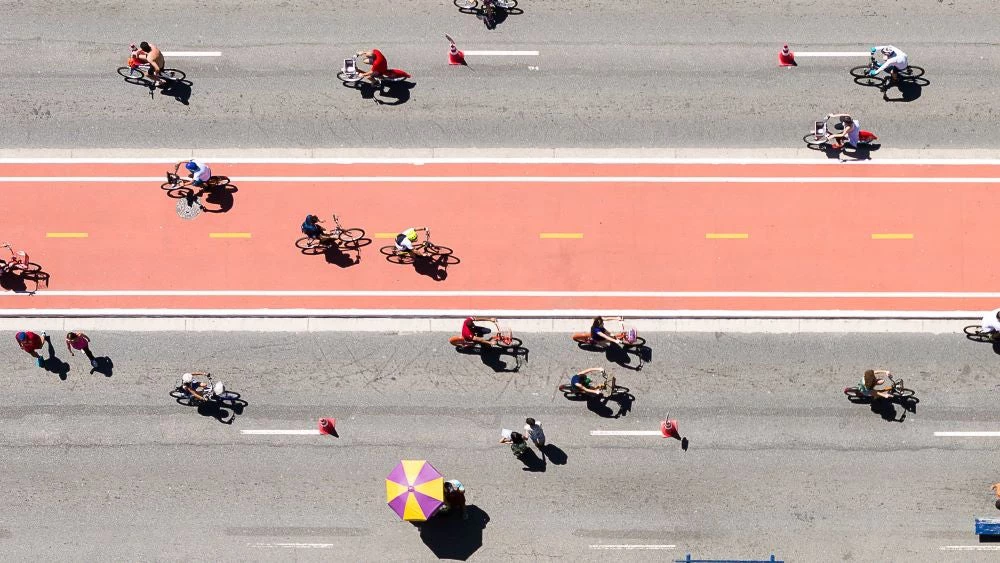 Cycling can be more than just a mode of transport; it can help cities reinvent themselves to become greener, more inclusive, and more livable places.
Cycling can be more than just a mode of transport; it can help cities reinvent themselves to become greener, more inclusive, and more livable places.
Imagine a city where the streets buzz with the energy of pedestrians and cyclists, where the air is cleaner, and the sound and smells of traffic are a distant memory. This city is not just a quiet, serene space but also a hub of economic vitality. The streets are alive with bustling local markets and cafes, thriving on foot traffic. With drastically reduced vehicle emissions, the city contributes to mitigating climate change and supports better health for its citizens.
Could this be the future of urban mobility? It could be. But how?
In many cities across the globe, the air is heavy with exhaust fumes, making walking or cycling more of a challenge than a choice. Growing up in a village, cycling to school and my friend's houses was a no-brainer—it was convenient and didn't cost anything. Most importantly, it was also the only mode of transport we had besides walking. My parents and neighbors used bikes to carry the bulk of vegetables and fish to the city for sale, which contributed to the family’s income. Biking also made it possible for us kids to get to the middle and high schools in town, as our village, like most, only had an informal elementary school up to the 4th grade.
But times have changed. With increased motorization, it wouldn't be safe today. I’ve lived and worked in many places, both in developing and developed countries, where walking and cycling felt downright dangerous—especially when you have to share limited road space with cars and motorbikes flying around you.
But today, the transformation in some urban centers is nothing short of miraculous. Over the last few years, many cities have taken decisive action to support active mobility, especially in the wake of the COVID-19 pandemic. Examples include bike-share programs (some are even free), new and protected bike lanes, and pedestrian zones. These programs have shown that walking and cycling can be more than just modes of transport; they can help cities reinvent themselves to become greener, more inclusive, and more livable places. However, many places still don’t have good pedestrian and cycling infrastructure.
The World Bank is playing an active role in leading this transformation. For example, we just completed a program two years ago in Tianjin, China that delivered active mobility infrastructure at scale with 126 km of cycle lanes added or widened, streetscaping, and public space redevelopment to better connect people to public transport safely and efficiently.
We are now working in Argentina, Brazil, Colombia, Peru, Senegal, and Tanzania on a wide range of active mobility programs. Our support includes financing for the construction or upgrading of active mobility infrastructure, such as dedicated bike lanes or pedestrian pathways. Beyond infrastructure investments, another important focus of our work is to help strengthen local institutions and provide the necessary technical guidance to ensure that active mobility can become an integral part of urban planning and policy. In other words, the World Bank's role in this journey is multifaceted—it provides financial support, technical expertise, capacity building, and policy advice.
A vision for healthier, more sustainable cities
A report prepared by the Institute for Transport and Development Policy (ITDP) and the World Bank, The Path Less Travelled: Scaling Up Active Mobility to Capture Economic and Climate Benefits, demonstrates that the benefits of active mobility extend far beyond positive environmental impacts. Economically, it's a game-changer. Improved cycling and walking infrastructure can lead to significant cost savings in public health and urban maintenance. Environmentally, it supports our efforts to mitigate climate change, reducing our carbon footprint, one step and one pedal at a time.
The key points of the report are illustrated through case studies in five cities—Addis Ababa, Buenos Aires, Dar es Salaam, Lima, and Tianjin. The findings are revealing and offer insights into action, for example:
-
Successful active mobility investments in low and middle-income countries are not only needed but also achievable and scalable through varied replicable mechanisms.
-
Active mobility initiatives offer significant benefits, especially when integrated with public transport systems and designed with safety in mind, such as expanded public transport ridership (and revenue), heath improvement and heath care savings through more physical exercise, improved air quality and road safety, high returns on investment, and reductions in urban transport's greenhouse gas emissions.
In countries where resources are scarce, the challenges are greater. But so are the opportunities. The World Bank's work in these regions is not just about building infrastructure—it's also about making cities cleaner, more efficient, and more equitable.
The World Bank's insights and experience offer a roadmap for success. They show us that investing in active mobility is not just an investment in infrastructure but also in health, the environment, and vibrant urban economies. Governments, the private sector, civil society, and development institutions need to rethink their approach to developing urban spaces. We need to make them more inclusive and sustainable. After all, we share a common goal—to create more efficient cities that offer better living spaces for everyone.
A lot of work needs to be done to scale up active mobility, especially in low- and middle-income countries. We need better project designs and better ways to track mobility investments. We need a standardized approach for evaluating the costs and benefits of active mobility infrastructure. We need more funding, both from public and private sources, including tapping into innovative finance such as climate finance. Governments need to develop national mobility plans and guidelines for implementing them.
When I imagine the future, I see cities where the streets are alive with the laughter of children, where the air is fresh, and where walking and cycling are integral parts of our daily lives. This is the dream, and it's within our reach. Let's make it happen.
This work was developed jointly by the World Bank and the Institute for Transportation and Development Policy (ITDP). The World Bank team was led by Winnie Wang, Senior Transport Specialist, Georges Darido, Lead Urban Transport Specialist, and Lama Bou Mjahed, Consultant. The ITDP team was led by Dana Yanocha, Research Manager, and Jacob Mason, Research Director.
Related:
Report: The Path Less Travelled: Scaling Up Active Mobility to Capture Economic and Climate Benefits
Report: Transport Decarbonization Investment Series: Investment for Momentum in Active Mobility
Transforming Transport 2022: New momentum and a fresh focus
With COVID-19, the case for sustainable transport is stronger than ever


Join the Conversation